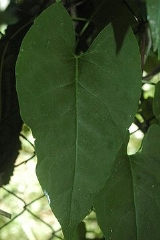
Fallopia multiflora
Encyclopedia
Fallopia multiflora is a species of Fallopia
native to central and southern China
.
It is a herbaceous
perennial
vine
growing to 2–4 m tall from a woody tuber
. The leaves
are 3–7 cm long and 2–5 cm broad, broad arrowhead-shaped, with an entire margin. The flower
s are 6–7 mm diameter, white or greenish-white, produced on short, dense panicle
s up to 10–20 cm long in summer to mid autumn. The fruit
is an achene
2.5–3 mm long.
It is also commonly used in chinese medicine.
Fallopia
Fallopia is a genus of about 12–15 species of flowering plants in the family Polygonaceae, often included in a wider treatment of the related genus Polygonum in the past. The genus is native to temperate and subtropical regions of the Northern Hemisphere...
native to central and southern China
China
Chinese civilization may refer to:* China for more general discussion of the country.* Chinese culture* Greater China, the transnational community of ethnic Chinese.* History of China* Sinosphere, the area historically affected by Chinese culture...
.
It is a herbaceous
Herbaceous
A herbaceous plant is a plant that has leaves and stems that die down at the end of the growing season to the soil level. They have no persistent woody stem above ground...
perennial
Perennial plant
A perennial plant or simply perennial is a plant that lives for more than two years. The term is often used to differentiate a plant from shorter lived annuals and biennials. The term is sometimes misused by commercial gardeners or horticulturalists to describe only herbaceous perennials...
vine
Vine
A vine in the narrowest sense is the grapevine , but more generally it can refer to any plant with a growth habit of trailing or scandent, that is to say climbing, stems or runners...
growing to 2–4 m tall from a woody tuber
Tuber
Tubers are various types of modified plant structures that are enlarged to store nutrients. They are used by plants to survive the winter or dry months and provide energy and nutrients for regrowth during the next growing season and they are a means of asexual reproduction...
. The leaves
Leaf
A leaf is an organ of a vascular plant, as defined in botanical terms, and in particular in plant morphology. Foliage is a mass noun that refers to leaves as a feature of plants....
are 3–7 cm long and 2–5 cm broad, broad arrowhead-shaped, with an entire margin. The flower
Flower
A flower, sometimes known as a bloom or blossom, is the reproductive structure found in flowering plants . The biological function of a flower is to effect reproduction, usually by providing a mechanism for the union of sperm with eggs...
s are 6–7 mm diameter, white or greenish-white, produced on short, dense panicle
Panicle
A panicle is a compound raceme, a loose, much-branched indeterminate inflorescence with pedicellate flowers attached along the secondary branches; in other words, a branched cluster of flowers in which the branches are racemes....
s up to 10–20 cm long in summer to mid autumn. The fruit
Fruit
In broad terms, a fruit is a structure of a plant that contains its seeds.The term has different meanings dependent on context. In non-technical usage, such as food preparation, fruit normally means the fleshy seed-associated structures of certain plants that are sweet and edible in the raw state,...
is an achene
Achene
An achene is a type of simple dry fruit produced by many species of flowering plants. Achenes are monocarpellate and indehiscent...
2.5–3 mm long.
It is also commonly used in chinese medicine.

